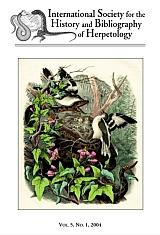




Related bibliographies:
Reptiles
 Worm Lizards Worm Lizards
 Bipedidae Bipedidae
North America






































































































































































































































































































































| |

Bibliography of the genus
Bipes (Two-legged Worm Lizards)

(Reptilia: Amphisbaenia: Bipedidae)
Note:
In order to limit redundancy, relevant literature indexed in the related bibliographies in the left column may not have been included in this page. For a comprehensive search of literature, these bibliographies should therefore also be consulted.
Bipes in general
 |
Campbell, J.H. 1980. Edwin Jame's report on Bipes reconsidered. Herpetological Review 11(1): 6-7.
Cole, C.J.; Gans, C. 1987. Chromosomes of Bipes, Mesobaena, and other amphisbaenids (Reptilia), with comments on their evolution. American Museum Novitates 2869: 1-9.
Dundee, H.A. 1980. A comment on J. Howard Campbell's Bipes report. Herpetological Review 11(3): 74, 76.
Flores-Villela, O.A.; Smith, H.M.; Chiszar, D.; Zamudio, G. 2004. Long-neglected information on the discovery of Bipes (Reptilia: Amphisbaenia). International Society for the History and Bibliography of Herpetology Newsletter and Bulletin 5(1): 18-22.
Flores-Villela, O.A.; Smith, H.M.; Chiszar, D.; Zamudio, G. 2004. Long-neglected information on the discovery of Bipes (Reptilia: Amphisbaenia). Bibliotheca Herpetologica 5(1): 18-22.
Gans, C.; Pappenfuss, T. 1980. There is no evidence that Bipes occurs in the U.S. Herpetological Review 11(3): 74.
Greer, A.E.; Gans, C. 1983. The amphisbaenian carpus: how primitive is it? Journal of Herpetology 17(4): 406.
Horstman, G.P. 1997. A logical, systematic analysis of a 177-year-old herpetological controversy: the Stephen H. Long Expedition (1820) amphisbaenid encounter. Bulletin of the Chicago Herpetological Society 33(1): 1-5.
Kim, Y.J.; Gorman, G.C.; Papenfuss, T.; Roychoudhury, A.K. 1976. Genetic relationships and genetic variation in the amphisbaenian genus Bipes. Copeia 1976(1): 120-124.
Papenfuss, T.J. 1980. A comparative study of the ecology and systematics of the species within the amphisbaenian genus Bipes. Dissertation Abstracts International B Sciences and Engineering 41(1): 99-100.
Papenfuss, T.J. 1982. The ecology and systematics of the amphisbaenian genus Bipes. Occasional Papers of the California Academy of Sciences 136: 1-42.
Shaw, C.E. 1962. Bipes the elusive two-legged lizard. Zoonooz 35(8): 10-15.
Smith, H.M.; Holland, R.L. 1981. Still more on Bipes. Herpetological Review 12(1): 8-9.
Taylor, E.H. 1938. Does the amphisbaenid genus Bipes occur in the United States? Copeia 1938: 202.
Walls, J.G. 1979. Amphisbaenians. Tropical Fish Hobbyist 27(8): 16.
Wright, J.W.; Mason, W.M. 1981. Bipes in Alta California. Herpetological Review 12(3): 76-77.
|
Bipes biporus
 |
Dial, B.E.; Gatten, R.E.; Kamel, S. 1987. Energetics of concertina locomotion in Bipes biporus (Reptilia: Amphisbaenia). Copeia 1987(2): 470-477.
Hollingsworth, B.; Frost, D.R. 2007. Bipes biporus. The IUCN Red List of Threatened Species 2007: e.T63723A12710548. http://dx.doi.org/10.2305/IUCN.UK.2007.RLTS.T63723A12710548.en.
Kearney, M. 2003. Diet in the Amphisbaenian Bipes biporus. Journal of Herpetology 37(2): 404-408.
Macey, J.R.; Schulte, J.A.; Larson, A.; Papenfuss, T.J. 1998. Tandem duplication via light-strand synthesis may provide a precursor for mitochondrial genomic rearrangement. Molecular Biology and Evolution 15(1): 71-75.
O'Shea, M. 2001. The creature from the slack sand dune. Herptile 26(2): 64-70.
Peralta-Garcia, A.; Samaniego-Herrera, A.; Valdez-Villavicencio, J.H. 2007. Registros nuevos de reptiles en Islas del noroeste de Mexico. Acta Zoologica Mexicana Nueva Serie 23(1): 179-182.
Wever, E.G.; Gans, C. 1972. The ear and hearing of Bipes biporus. Proceedings of the National Academy of Sciences of the United States of America 69(9): 2714-2716.
|
Bipes canaliculatus
 |
Alvarez, T. 1964. The amphisbaenid lizard Bipes canaliculatus in Michoacán, México. Herpetologica 20: 202.
Alvarez, T. 1964. Variación y descripción de una subespecie de Bipes caniculatus (Reptilia; Squamata) de Michoacán, Mexico. Anales de la Escuela Nacional de Ciencias Biologicas Mexico 13: 145-152.
Böhme, W. 1989. Zur systematischen Stellung der Amphisbanen (Reptilia: Squamata), mit besonderer Berücksichtigung der Morphologie des Hemipenis. Zeitschrift für Zoologische Systematik und Evolutionsforschung 27(4): 330-337.
Campos-Rodriguez, J.I.; Lopez-Vidal, J.C. 2007. Annotated checklist of type specimens in the herpetological collection of the Escuela Nacional de Ciencias Biologicas, I. P. N., Mexico. Southwestern Naturalist 52(2): 323-326.
Davis, W.B.; Dixon, J.R. 1961. Reptiles (exclusive of snakes) of the Chilpancingo region, Mexico. Proceedings of the Biological Society of Washington 74: 37-56.
Flores-Villela, O.A.; Smith, H.M.; Chiszar, D.; Zamudio, G. 2004. Long-neglected information on the discovery of Bipes (Reptilia: Amphisbaenia). International Society for the History and Bibliography of Herpetology Newsletter and Bulletin 5(1): 18-22.
Hodges, W.L.; Perez-Ramos, E. 2001. New localities and natural history notes on Bipes canaliculatus in Guerrero, Mexico. Herpetological Review 32(3): 153-156.
Ponce-Campos, P.; García Aguayo, A. 2007. Bipes canaliculatus. The IUCN Red List of Threatened Species 2007: e.T63724A12710708. http://dx.doi.org/10.2305/IUCN.UK.2007.RLTS.T63724A12710708.en.
Smith, H.M.; Smith, R.B. 1977. Synopsis of the herpetofauna of Mexico. Vol. 5. Guide to Mexican amphisbaenians and crocodilians. Bibliographic addendum 2. John Johnson, North Bennington, Vermont. 187 pp.
Wicker, R. 1987. Handwuhlen in Frankfurt. Naturwissenschaftliche Rundschau 40(5): 197-198.
|
Bipes tridactylus
 |
Canseco-Márquez, L.; Campbell, J.A.; Ponce-Campos, P.; Muñoz-Alonso, A. 2007. Bipes tridactylus. The IUCN Red List of Threatened Species 2007: e.T63725A12710841. http://dx.doi.org/10.2305/IUCN.UK.2007.RLTS.T63725A12710841.en.
|
| | 














































































































































































|

